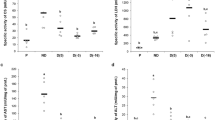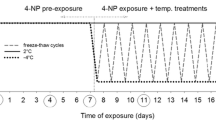Summary
-
1.
The levels of glycogen, lipid, protein, polyols (glycerol and sorbitol), sugars, amino acids, adenylates, and other intermediary metabolites were measured in the overwintering, third instar larvae of the gall fly,Eurosta solidaginis, sampled at specified temperatures during a controlled (1°C per day decrease) low temperature acclimation of the larvae from 15° to − 30°C.
-
2.
Glycogen reserves were depleted as temperature was decreased, the decrease in glycogen fully accounting for the observed increases in glycerol, sorbitol, glucose, and trehalose in the larvae at low temperatures. Protein and total glyceride reserves of the larvae, however, were not altered during low temperature acclimation.
-
3.
Temperature specific patterns of glycerol and sorbitol accumulation were found. Glycerol concentrations, which were 65% of maximum at 15°C, reached a plateau in concentration of 235 μmol/g wet wt. between 5 and 0°C. Sorbitol first appeared in larvae at 5° C and then increased in concentration rapidly as temperature decreased further to reach a plateau level of 145 μmol/g wet wt. by −10°C.
-
4.
The free amino acid pool increased in size by 50% during acclimation from 15 to −5°C, this increase due largely to a 24 μmol/g wet wt. increase in proline concentration and a smaller 4.4 μmol/g wet wt. increase in alanine.
-
5.
Arginine phosphate and ATP levels, as well as energy charge and the ratio [ATP]/[ADP]·[Pi], remained high and constant in larvae acclimated to temperatures as low as −5°C but in larvae acclimated to −30°C phosphagen and ATP levels had declined by 54 and 29% respectively and energy charge had decreased from 0.92 to 0.82.
-
6.
The data suggest that aerobic metabolism with continued polyol synthesis is fully active in these larvae at temperatures as low as −10°C. However, below −10°C, the temperature at which hemolymph freezing takes place, mitochondria appear to be metabolically inactive. Evidence for this includes the cessation of polyol, sugar, and amino acid accumulation by this temperature and the drop in arginine phosphate, ATP, and energy charge and build-up of lactate at −30°C.
-
7.
The regulation of metabolism inE. solidaginis larvae during low temperature acclimation is discussed with particular emphasis on the possible metabolic ‘switches’ regulating the flow of carbon to glycerol versus sorbitol synthesis.
Similar content being viewed by others
References
Baust JG, Edwards JS (1979) Mechanisms of freezing tolerance in the antarctic midge,B. antarctica. Physiol Entomol 4:1–5
Baust JG, Grandee R, Condon G, Morrissey RE (1979) Diversity of overwintering strategies utilized by separate populations of gall insects. Physiol Zool 52:572–580
Bergmeyer HU, Gruber W, Gutman I (1974)d-Sorbitol. In: Bergmeyer HU (ed) Methods of enzymatic analysis. Academic Press, New York, pp 1323–1326
Chino H (1960) Enzymatic pathways in the formation of sorbitol and glycerol in the diapausing egg of the silkworm,Bombyx mori. I. On the polyol dehydrogenases. J Insect Physiol 5:1–15
Erecinska M, Stubbs M, Miyata Y, Ditre CM, Wilson DF (1977) Regulation of cellular metabolism by intracellular phosphate. Biochim Biophys Acta 462:20–35
Eggstein M, Kuhlmann E (1974) Triglycerides and glycerol: Determination after alkaline hydrolysis. In: Bergmeyer HU (ed) Methods of enzymatic analysis. Academic Press, New York, pp 1825–1831
Folch J, Lees M, Sloane Stanley GH (1957) A simple method for the isolation and purification of total lipids from animal tissues. J Biol Chem 226:497–509
Kageyama T, Takahashi SY, Ohnishi E (1973) Acid phosphatases in the eggs of the silkworm,Bombyx mori: purification and properties. Insect Biochem 3:373–388
Keppler D, Decker K (1974) Glycogen: Determination with amyloglucosidase. In: Bergmeyer HU (ed) Methods of enzymatic analysis. Academic Press. New York, pp 1127–1131
Lowry OH, Passonneau JV (1972) A flexible system of enzymatic analysis. Academic Press, New York, pp 86–89, 146–218
Mandel LJ, Riddle TG, Storey JM (1980) Role of ATP in respiratory control and active transport in tobacco hornworm midgut. Am J Physiol 238:C10-C14
Mansingh A (1967) Changes in the free amino acids of the haemolymph ofAntheraea pernyi during induction and termination of diapause. J Insect Physiol 13:1645–1655
Morrissey RE, Baust JG (1976) The ontogeny of cold tolerance in the gall fly,Eurosta solidagensis. J Insect Physiol 22:431–437
Raison JK (1973) Temperature-induced phase changes in membrane lipids and their influence on metabolic regulation. Soc Exp Biol (Symp) 27:485–512
Ramaiah A (1974) Pasteur effect and phosphofructokinase. Curr Top Cell Regul 8:297–345
Sacktor B (1970) Regulation of intermediary metabolism, with special reference to the control mechanism in insect flight muscle. Adv Insect Physiol 7:267–347
Salt RW (1957) Natural occurrence of glycerol in insects and its relation to their ability to survive freezing. Can Entomol 89:491–494
Storey KB, Storey JM (1978) Energy metabolism in the mantle muscle of the squid,Loligo pealeii. J Comp Physiol 123:169–175
Storey KB, Baust JG, Beuscher P (1981) Determination of water ‘bound’ by soluble subcellular components during low temperature acclimation in the gall fly larva.Eurosta solidagensis. Cryobiology 18:315–321
Takahashi SY, Kajiura T, Kageyama T, Ohnishi E (1974) Polyol dehydrogenases from silkworm eggs: purification and properties. Insect Biochem 4:33–45
Turbeck BO (1974) A study of the concentrically laminated concretions, ‘spherites’, in the regenerative cells of the midgut of lepidopterous larvae. Tissue Cell 6:627–640
Yelenosky G (1979) Accumulation of free proline in citrus leaves during cold hardening of young trees in controlled temperature regimes. Plant Physiol 64:425–427
Author information
Authors and Affiliations
Rights and permissions
About this article
Cite this article
Storey, K.B., Baust, J.G. & Storey, J.M. Intermediary metabolism during low temperature acclimation in the overwintering gall fly larva,Eurosta solidaginis . J Comp Physiol B 144, 183–190 (1981). https://doi.org/10.1007/BF00802756
Accepted:
Issue Date:
DOI: https://doi.org/10.1007/BF00802756




